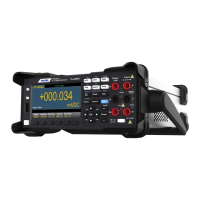69
significant proportion of the input resistance of the multimeter itself. The following figure is
a schematic diagram of this error source.
Rs
HI
Vs
LO
VS = ideal DUT voltage
RS = DUT source resistance
Ri = multimeter input resistance (10MΩ or >10GΩ)
If you want to reduce the load error effect and reduce the noise interference, for 100
mVDC, 1VDC and 10 VDC range, the input impedance of a multimeter can be set to "> 10
G Ω", for 100 VDC and 1000 VDC range, will remain at 10 M Ω input resistance.
Noise Rejection
Rejecting power line noise voltage
One of the advantages of the integrated analog-to-digital (A/D) converter is its ability to
reject the power line related noise that exists in the DC input signal. This feature is known
as normal noise rejection, or NMR. The multimeter realizes normal noise rejection by
integrating the average DC input over a fixed time period. If the integration time is set to
integer multiples of the power supply line period (PLC), these errors (and their harmonics)
will be averaged close to zero.
The multimeter offers three integral options (1, 10 and 100 PLC) for normal noise
suppression. The multimeter first measures the power supply frequency (50 Hz or 60 Hz)
and then determines the corresponding integration time. A complete list of normal noise
suppression, increased RMS noise approximation, read rate, and resolution for each
integral setting.
理想
Ri
万用表

